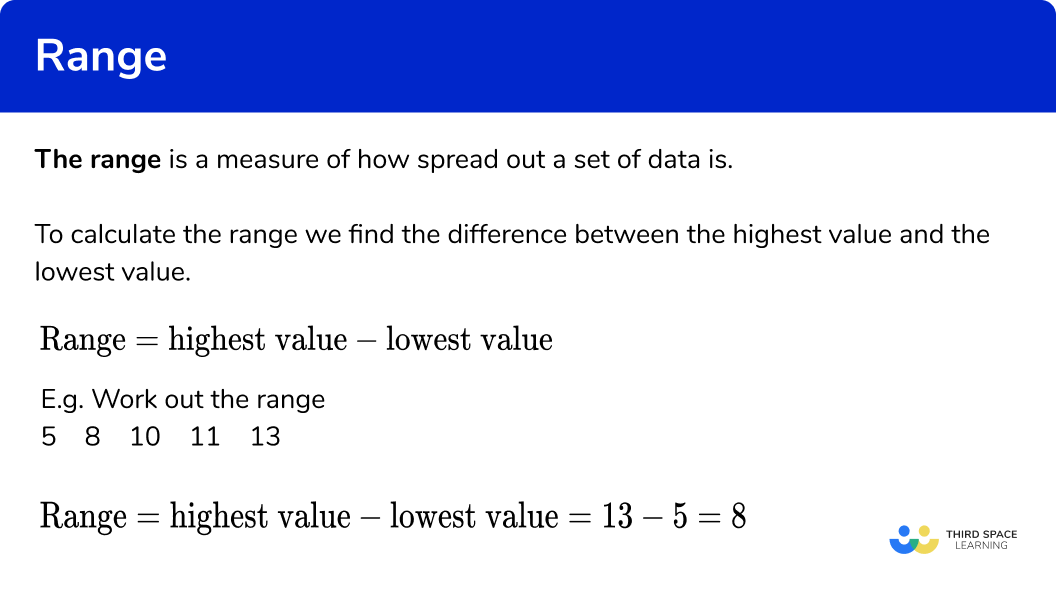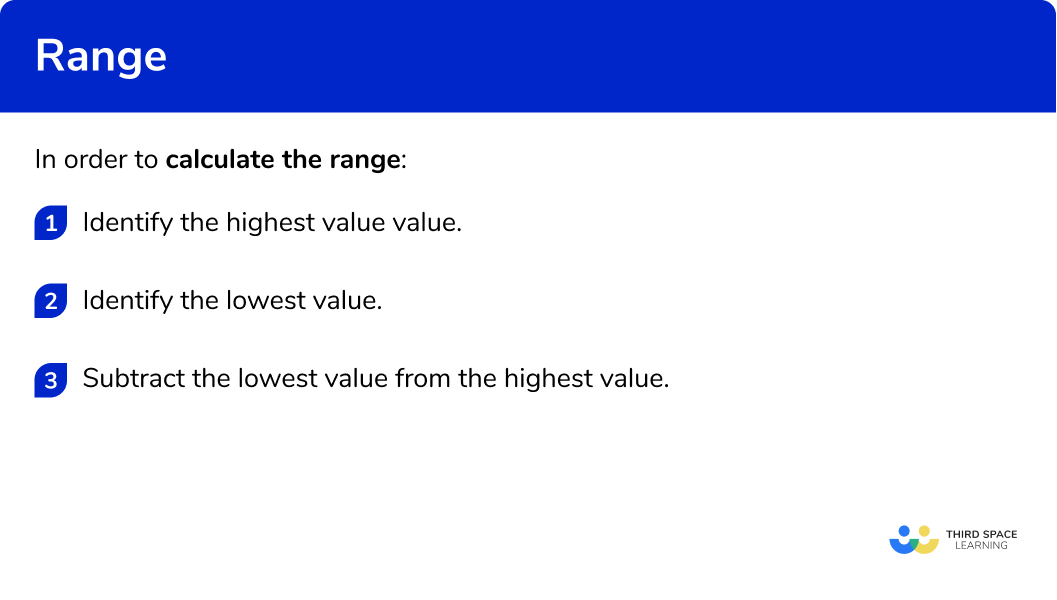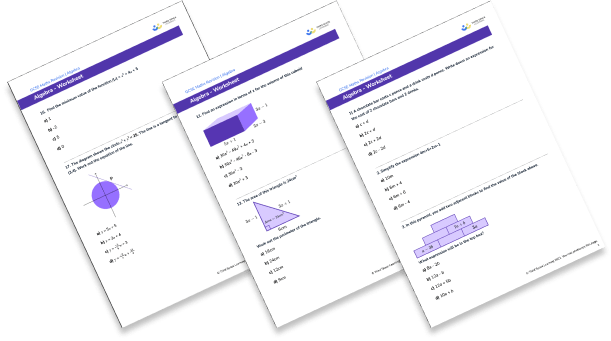One to one maths interventions built for KS4 success
Weekly online one to one GCSE maths revision lessons now available
In order to access this I need to be confident with:
Negative numbers Arithmetic Decimals Fractions RoundingThis topic is relevant for:

Range
Here we will learn about the range in maths, including what the range is and how to calculate it. We will also learn how to solve problems involving the range.
There are also range worksheets based on Edexcel, AQA and OCR exam questions, along with further guidance on where to go next if you’re still stuck.
What is range?
The range is a measure of how spread out a set of data is.
To calculate the range we find the difference between the highest value and the lowest value. (The highest value is sometimes called the largest value or largest number. The lowest value is sometimes referred to as the smallest value or smallest number).
\text{Range}=\text{highest value}-\text{lowest value}For example, work out the range
5 \quad \quad 8 \quad \quad 10 \quad \quad 11 \quad \quad 13 \text{Range}=\text{highest value}-\text{lowest value}=13-5=8What is range?

Averages and range
The range is a type of statistic. Other statistics include the mean, the median and the mode. Each statistic allows us to analyse the data set, looking at: the spread of the data (the range), the location of the middle value (the median), the average value (the mean), and the most common value (the mode).
When we find the average for a set of data, we are referring to the mean average.
How to calculate range
In order to calculate the range:
- Identify the highest value.
- Identify the lowest value.
- Subtract the lowest value from the highest value.
How to calculate range


Mean, median, mode and range worksheet

Get your free range maths worksheet of 20+ mean, median, mode and range questions and answers. Includes reasoning and applied questions.
DOWNLOAD FREE
Mean, median, mode and range worksheet

Get your free range maths worksheet of 20+ mean, median, mode and range questions and answers. Includes reasoning and applied questions.
DOWNLOAD FREERelated lessons on mean, median, mode
Range is part of our series of lessons to support revision on mean, median, mode. You may find it helpful to start with the main mean, median, mode lesson for a summary of what to expect, or use the step by step guides below for further detail on individual topics. Other lessons in this series include:
Range maths examples
Example 1: finding the range for an ordered list of numbers
Work out the range of this set of numbers
3 \quad \quad 6 \quad \quad 8 \quad \quad 10 \quad \quad 12 \quad \quad 15- Identify the highest value.
Look through the set of values and find the highest value (or highest value).
The highest value is 15 .
2Identify the lowest value.
Look through the set of values and find the lowest value (or lowest number).
The lowest value is 3.
3Subtract the lowest value from the highest value.
The range is the difference between the highest and lowest values.
\text{Range}=\text{highest value}-\text{lowest value}=15-3=12The range is 12.
Example 2: finding the range for an ordered list of numbers
Work out the range of this set of numbers
1 \quad \quad 3 \quad \quad 4 \quad \quad 11 \quad \quad 13 \quad \quad 14 \quad \quad 18Identify the highest value.
Look through the set of values and find the highest value (or highest value).
The highest value is 18.
Identify the lowest value.
Look through the set of values and find the lowest value (or lowest number).
The lowest value is 1.
Subtract the lowest value from the highest value.
The range is the difference between the highest and lowest values.
\text{Range}=\text{highest value}-\text{lowest value}=18-1=17
The range is 17.
How to solve problems involving range
In order to use the range with problem solving:
- Write down how to find the range.
- Substitute the values we are given.
- Work out the missing value.
Problems involving range examples
Example 3: finding the highest value
The range of a set of data is 12.
The lowest value is 25.
Work out the highest value.
Write down how to find the range.
Substitute the values we are given.
Work out the missing value.
To find the highest value we will need to add the range to the lowest value.
\text{Highest value}=12+25=37
The highest value is 37.
This answer can be doubled checked:
\text{Range}=\text{highest value}-\text{lowest value}=37-12=25 \; \color{green} ✔
Example 4: finding the highest value
The range of a set of data is 14.
The lowest value is 38.
Work out the highest value.
Write down how to find the range.
Substitute the values we are given.
Work out the missing value.
To find the highest value we will need to add the range to the lowest value.
\text{Highest value}=38+14=52
The highest value is 52.
This answer can be doubled checked:
\text{Range}=\text{highest value}-\text{lowest value}=52-38=14 \; \color{green} ✔
Example 5: finding the lowest value
The range of a set of data is 8.
The highest value is 14.
Work out the lowest value.
Write down how to find the range.
Substitute the values we are given.
Work out the missing value.
To find the lowest value we will need to subtract the range from the highest value.
\text{lowest value}=14-8=6
The lowest value is 6.
This answer can be doubled checked:
\text{Range}=\text{highest value}-\text{lowest value}=14-6=8 \; \color{green} ✔
Example 6: finding the lowest number
The range of a set of data is 17.
The highest value is 28.
Work out the lowest value.
Write down how to find the range.
Substitute the values we are given.
Work out the missing value.
To find the lowest value we will need to subtract the range from the highest value.
\text{Lowest value}=28-17=11
The lowest value is 11.
This answer can be doubled checked:
\text{Range}=\text{highest value}-\text{lowest value}=28-11=17 \; \color{green} ✔
Common misconceptions
- Lowest and highest values
Sometimes the list of values is not in order of size. Make sure that you are definitely using the lowest and highest values.
- Remember to calculate the range
Writing the range as lowest number to highest number with a dash in between is incorrect. To calculate the range you need to find the difference between these values.
E.g. What is the range of this set of values?
1 \quad \quad 3 \quad \quad 6 \quad \quad 8
The range is not 1-8 or 1- to -8
The range is 8-1=7
Practice range maths questions
1. Work out the range of this set of data:
3 \quad \quad 7 \quad \quad 9 \quad \quad 9 \quad \quad 10 \quad \quad 11




The range is calculated by finding the difference between the highest and lowest values.
\text{Range}=\text{highest value}-\text{lowest value}=11-3=8
2. Work out the range of this set of data:
8 \quad \quad 10 \quad \quad 13 \quad \quad 14 \quad \quad 17 \quad \quad 21




The range is calculated by finding the difference between the highest and lowest values.
\text{Range}=\text{highest value}-\text{lowest value}=21-8=13
3. The range of a set of data is 6. The lowest value is 5. What is the highest value?




The highest value is found by adding the range on to the lowest value.
\text{Highest value}=\text{lowest value}+\text{Range}=5+6=11
4. The range of a set of data is 17. The lowest value is 14. What is the highest value?




The highest value is found by adding the range on to the lowest value.
\text{Highest value}=\text{lowest value}+\text{Range}=14+17=31
5. The range of a set of data is 9. The highest value is 17. What is the lowest value?




The highest value is found by subtracting the range from the highest value.
\text{Lowest value}=\text{highest value}-\text{Range}=17-9=8
6. The range of a set of data is 16. The highest value is 34. What is the lowest value?




The highest value is found by subtracting the range from the highest value.
\text{Lowest value}=\text{highest value}-\text{Range}=34-16=18
Range maths GCSE questions
1. Here is a list of numbers.
9 \quad \quad 12 \quad \quad 18 \quad \quad 19 \quad \quad 21 \quad \quad 25 \quad \quad 28
Work out the range of the numbers in the list.
(2 marks)
(1)
\text{Range}=19
(1)
2. Here is a list of numbers.
12 \quad \quad 19 \quad \quad 21 \quad \quad 17 \quad \quad 13 \quad \quad 20
Work out the range of the numbers in the list.
(2 marks)
(1)
\text{Range}=9
(1)
2. Jack chooses four numbers.
The highest of these four numbers is 23.
The range of these four numbers is 17.
Find the lowest of these four numbers.
(2 marks)
(1)
\text{Lowest value}=6
(1)
Learning checklist
You have now learned how to:
- Work out the range
- Solve problems involving the range
The next lessons are
Still stuck?
Prepare your KS4 students for maths GCSEs success with Third Space Learning. Weekly online one to one GCSE maths revision lessons delivered by expert maths tutors.

Find out more about our GCSE maths tuition programme.